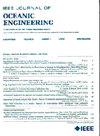UIE-SFIFormer: Underwater Image Enhancement Based on Physical-Guided Spatial–Frequency Interaction Transformer
IF 3.8
2区 工程技术
Q1 ENGINEERING, CIVIL
引用次数: 0
Abstract
Light scattering and absorption can cause color distortion, blurring, noise, and other issues in underwater images, negatively impacting their quality and posing significant challenges for underwater research and exploration. To deal with the problem, a novel underwater image enhancement method, the UIE-SFIFormer, has been proposed by designing the physical-guided spatial–frequency interaction Transformer. Specifically, the proposed physical guidance fusion module (PGFM) is designed to fuse the dark channel inverse transmission map, incorporating prior knowledge, such as brightness and depth, with the raw image to enhance missing physical information. Subsequently, the spatial–frequency feature extraction module (SFFEM) is utilized for further feature extraction of the fused image. Within SFFEM, Transformer is employed for spatial and frequency domain feature extraction to address nonlocal degradation and excessive fuzzy noise in underwater images. Building upon this foundation, a spatial–frequency interaction block is constructed to combine dual features through spatial–frequency-domain hybrid cross-attention. Finally, experimental results on five underwater test data sets demonstrated that the proposed UIE-SFIFormer has a better performance in restoring and enhancing underwater images than other methods.UIE-SFIFormer:基于物理引导空频交互变压器的水下图像增强
光的散射和吸收会导致水下图像的颜色失真、模糊、噪声等问题,对水下图像质量产生负面影响,给水下研究和探索带来重大挑战。为了解决这一问题,通过设计物理引导空频交互变压器,提出了一种新的水下图像增强方法UIE-SFIFormer。具体而言,提出的物理制导融合模块(PGFM)将暗信道反传输图与原始图像融合,将亮度和深度等先验知识与原始图像融合,以增强缺失的物理信息。随后,利用空间-频率特征提取模块(SFFEM)对融合图像进行进一步的特征提取。在SFFEM中,利用Transformer进行空间和频域特征提取,以解决水下图像的非局部退化和过度模糊噪声问题。在此基础上,构建了空间-频率交互块,通过空间-频率域混合交叉注意来结合双特征。最后,在五个水下测试数据集上的实验结果表明,所提出的ie - sfiformer在水下图像的恢复和增强方面比其他方法具有更好的性能。
本文章由计算机程序翻译,如有差异,请以英文原文为准。
求助全文
约1分钟内获得全文
求助全文
来源期刊

IEEE Journal of Oceanic Engineering
工程技术-工程:大洋
CiteScore
9.60
自引率
12.20%
发文量
86
审稿时长
12 months
期刊介绍:
The IEEE Journal of Oceanic Engineering (ISSN 0364-9059) is the online-only quarterly publication of the IEEE Oceanic Engineering Society (IEEE OES). The scope of the Journal is the field of interest of the IEEE OES, which encompasses all aspects of science, engineering, and technology that address research, development, and operations pertaining to all bodies of water. This includes the creation of new capabilities and technologies from concept design through prototypes, testing, and operational systems to sense, explore, understand, develop, use, and responsibly manage natural resources.
 求助内容:
求助内容: 应助结果提醒方式:
应助结果提醒方式:


